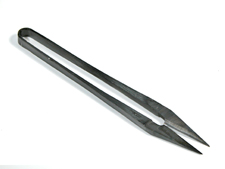Bonsai Tools
Bonsai tools are specialized tools which have evolved over hundreds of years with the art of bonsai. Good quality tools are made of forged, high-carbon steel to hold a sharp edge and will provide a lifetime of service if used and cared for properly.
Tools used for Pruning:
Leaf Pruners are used to defoliate trees. Their spring loaded action makes it easy to cut off each leaf at its petiole (stem)
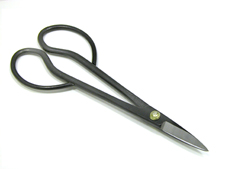
Shears (Light weight) come in various sizes and are used to cut everything from buds and leaves to stout branches and roots. Their long handles allow access to the interior of a tree without disturbing the outer branches.
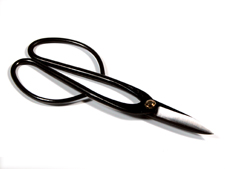
Shears: Medium weight
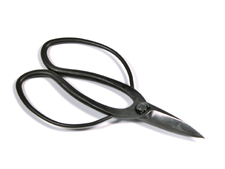
Shears: Heavy weight
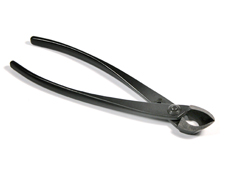
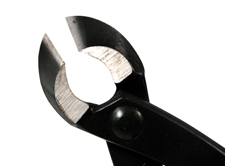
Concave Cutters come in three sizes and are used to cut branches. The angled, concave blade leaves a clean, hollow cut which heals more easily and leaves less of a pruning scar.
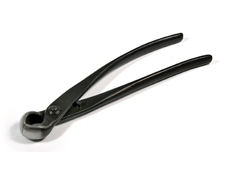
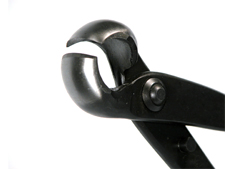
Knob Cutters or Spherical Cutters also come in three sizes and are used to cut branches at their base. These cutters leave a deep, hollow cut allowing the bark to heal with minimal pruning scar.
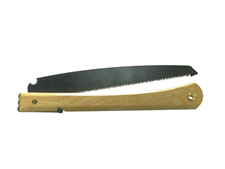
Saws are convenient when branches are too thick for Concave Cutters. Japanese pruning saws cut on the pull stroke for better control.
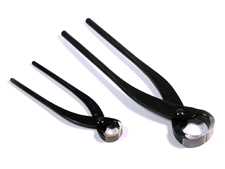
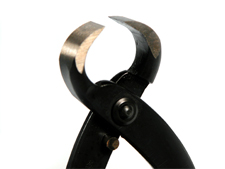
Root Cutters or Splitters come in three sizes and are used primarily to cut tough, fibrous roots, split branches and remove wood.
Tools used for Wiring:
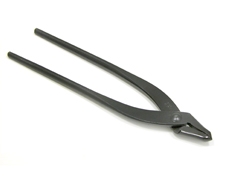
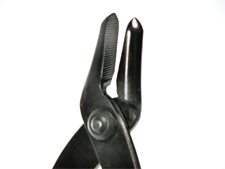
Pliers are used for bending and holding heavy wire when wiring branches. They can also be used to tear deadwood wood on branches when creating a jin.
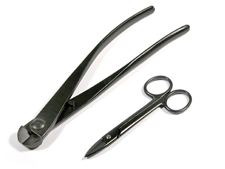
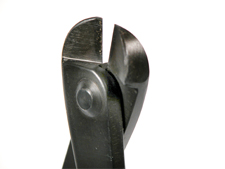
Wire Cutters: small, medium and heavy are used to cut wire from 6mm to 1mm thick. Their special shape allows for the removal of wire from branches without damaging the bark or branch.
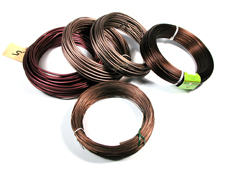
Bonsai Wire, made from anodized aluminum, comes in eight different thicknesses, from 1 mm to 6 mm in diameter. Conifers are usually wired with copper wire.
Tools used for Potting:
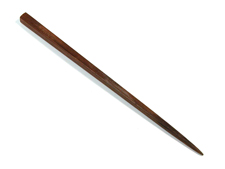
Chopsticks are inexpensive and extremely useful in teasing away soil from the root ball. They are also used to auger soil in between roots when potting a tree so as to leave no air pockets or cavities.

Scythe: The scythe can be used to separate a root bound tree from its container. It can also be used to saw through roots, especially overgrown sod-like root pads.
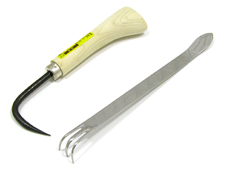
Root Hook and Root Rake are also used to comb out roots. The spatula on the Root Rake can be used to tamp down soil or separate a root-bound tree from its container.
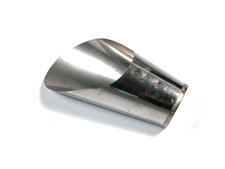
Soil Scoops are a convenient way of adding soil to the container when potting a tree. Their angled spout allow pouring the soil where needed without bumping into the trunk or branches.
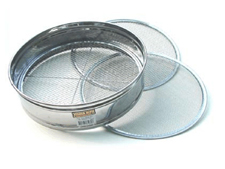
Set of Sieves:
Small (1/16” or 1.5 mm openings) Medium (1/8” or 3 mm openings.) Large (1/4 “ or 6 mm openings). These sieves are used to sift particles of varying sizes to achieve a consistent, coarse soil mix without the fine particles that can compromise the soil mix's porosity and free-draining properties.
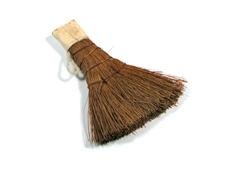
Broom: Use the broom to level and brush away excess potting medium.
Tools used for Carving:
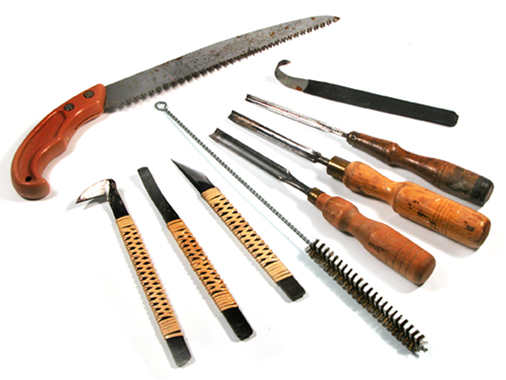
Splitters, Pliers, Knives, Scrappers, Wire Brushes, Gouges, Electric Rotary Grinders
All these tools and more, are used to carve deadwood when creating jin, shari, saba miki and driftwood.
Care and Maintenance of Bonsai Tools
• Examine your tools regularly.
• Don’t use tools for a purpose for which they were not designed.
• Never twist or turn a tools while it is being used.
• Try not to drop your tools on hard surfaces like concrete or stone.
• Don’t use your finely sharpened shears to cut roots that are in the soil. Particles of soil can dull and nick.
• Do not overload a tool. Instead make a series of smaller cuts or usealarger tool.
• Tools should be sharpened by a specialist.
• Clean your tools when finished. Alcohol or turpentine will remove sap.
• Apply a light coating of oil to surfaces and pivot point.
• Store in a dry, clean place where they will not be damaged by contact with each other or other objects.
BCI Education Committee
|
Chen Chang (Chair) China |
|
Sujata Bhat India |
|
David DeGroot USA |
|
Min Hsuan Lo Taiwan |
|
Bhavna Shah India |
|
Enrique Castaño Mexico |
|
Piotr Czerniachowski Poland |
Find BCI bonsai and viewing stone experts for your club’s next event.
BCI Instructors and Teachers are listed by country. All meet the criteria BCI has developed to ensure each instructor or teacher has the knowledge and experience to qualify for a listing in this section.
To be listed as a BCI Instructor or Teacher, refer to our guidelines and if you qualify, use the submission form for your application.
Allow two weeks for your application to be reviewed and your information listed on this website.
BCI Guidelines for Instructors and Teachers
(Guidelines or criteria an individual must meet to be listed)
Submit Your Application (Button linked to a form)
BCI Instructors and Teachers
Bonsai Pots
A bonsai pot is not just any pot! A bonsai pot serves a function beyond merely containing the tree and the potting medium. It is an integral part of the bonsai image, and must complement the tree in much the same way as a frame complements a painting.
Bonsai pots:
-are very beautiful, an art form requiring highly skilled artists.
-are much more shallow than regular plant pots, hence the frequent reference to bonsai ‘trays.’ 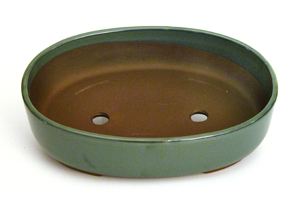
-are stoneware or ceramic, as opposed to the common earthenware flower pots. They have been fired to much higher temperatures, and thus are much more hardy.
-have huge drainage holes. These ‘25-cent-piece’ sized holes must have mesh screening in place over them to prevent the soil from running out the bottom of the pot.
-have feet, which raise the pot bottom from the bonsai bench, allowing draining water to run freely away. Their feet may be plain and straight, or curved and fancy.



Bonsai pots may be an unglazed, rich brown in color, or glazed to soft, subtle colours such as green, grey, blue, cream, or warm white. In shape they may be
round, square, octagonal, oval, or oblong. Their profile may be straight-sided, lipped, flared, or incurved.




A bonsai pot may be as small as a teacup, or even a thimble, or as large as a baby’s bath. Traditional, established guidelines help bonsaiists select the appropriate size, shape and color to best complement each tree style and species.
Pots for cascade and semi-cascade bonsai are, of necessity, much deeper, in order to balance the downward sweep of these two styles.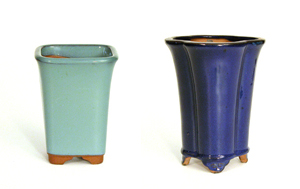
Until bonsai are ready for such fine pots as described here, but after they have been 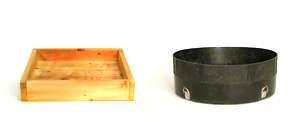
collected from the wild or lifted from the garden, they can be planted into ‘training pots’. These can be as simple as seed trays or even shallow wooden boxes lined with screen, as long as they are free draining. Training pots must be shallow, to encourage the tree roots to develop horizontally.
Beginners should beware of poorly-made pots, especially those with uneven bottoms, hollows in the feet, or carelessly made drain holes. All of these are serious flaws, as water may collect or be prevented from draining freely, causing root rot— one of the most common causes of tree mortality.
|
Bonsai pots:
-have feet, which raise the pot bottom from the bonsai bench, allowing draining water to run freely away. Their feet may be plain and straight, or curved and fancy.    Bonsai pots may be an unglazed, rich brown in color, or glazed to soft, subtle colours such as green, grey, blue, cream, or warm white. In shape they may be round, square, octagonal, oval, or oblong. Their profile may be straight-sided, lipped, flared, or incurved.
A bonsai pot may be as small as a teacup, or even a thimble, or as large as a baby’s bath. Traditional,established guidelines help bonsaiists select the appropriate size, shape and color to best complementeach tree style and species.
Pots for cascade and semi-cascade bonsai are, of necessity, much deeper, in order to balance the downward sweep of these two styles.
Until bonsai are ready for such fine pots as described here, but after they have been collected from the wild or lifted from the garden, they can be planted into ‘training pots’. These can be as simple as seed trays or even shallow wooden boxes lined with screen as long as they are free draining. Training pots must be shallow, to encourage the tree roots to develop horizontally.Beginners should beware of poorly-made pots, especially those with uneven bottoms, hollows in the feet, or carelessly made drain holes. All of these are serious flaws, as water may collect or be prevented from draining freely, causing root rot— one of the most common causes of tree mortality. |

